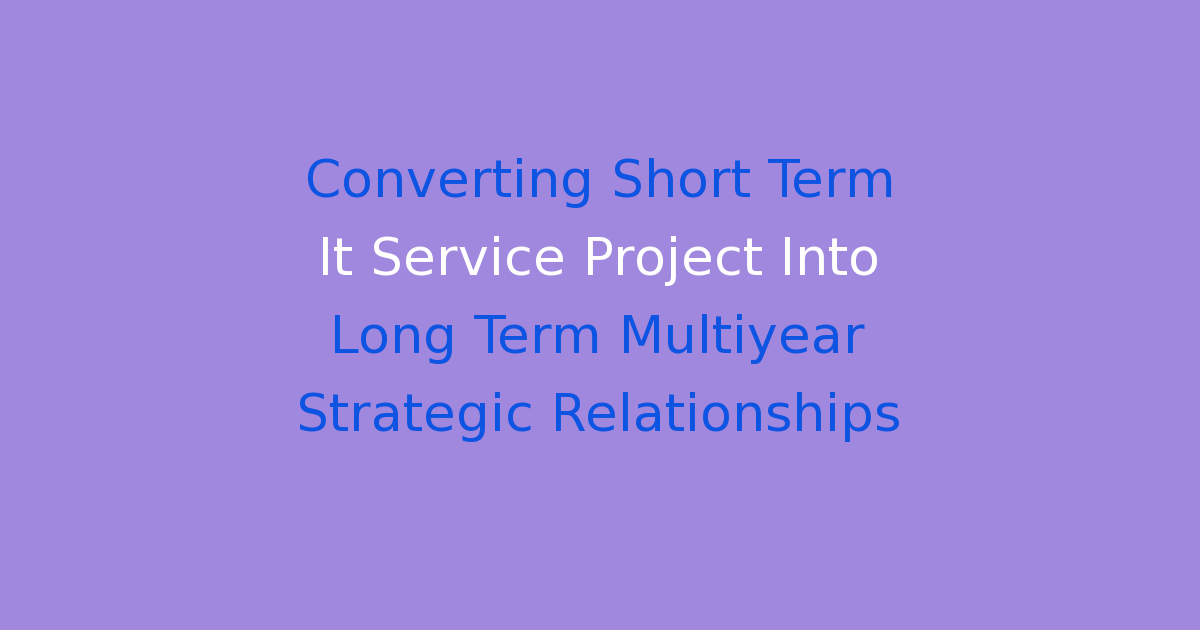transforming short-term IT service projects into long-term multiyear strategic relationships.
Converting Short Term IT Service Project into Long Term Multiyear Strategic Relationships
Introduction
In the dynamic field of Information Technology, short term IT service projects are a common occurrence. These projects are typically initiated to address specific business needs or solve immediate problems. However, in today’s competitive environment, there is a growing trend towards converting these short term projects into long term multiyear strategic relationships. This shift allows organizations to build sustainable partnerships with IT service providers, ensuring continuous innovation and value creation.
Problem Statement
The traditional approach to IT service projects involves engaging vendors on a project-by-project basis. While this may provide quick solutions, it often leads to fragmented relationships and limited scope for long term planning. Organizations may find themselves constantly searching for new vendors, negotiating contracts, and managing multiple projects simultaneously. This can be time-consuming and costly, with limited opportunities for strategic alignment.
Existing System
In the existing system, organizations tend to focus on short term goals and immediate needs. IT service projects are scoped narrowly, with a primary emphasis on deliverables and timelines. Vendors are selected based on specific project requirements, without considering their long term capabilities or strategic fit. As a result, organizations miss out on the opportunity to build lasting partnerships and harness the full potential of their IT service providers.
Disadvantages
The disadvantages of the existing system are clear. Short term IT service projects lack continuity and sustainability, leading to frequent disruptions and inefficiencies. Organizations may experience gaps in knowledge transfer, limited scalability, and a lack of strategic alignment with their IT service providers. This can hinder innovation and hinder the organization’s ability to stay competitive in the market.
Proposed System
To address these challenges, we propose converting short term IT service projects into long term multiyear strategic relationships. This approach involves shifting from a transactional to a relational model, where organizations engage with vendors in a more strategic and integrated manner. By forming long term partnerships, organizations can align their IT initiatives with business objectives, drive innovation, and create sustainable value over time.
Advantages
The advantages of adopting this proposed system are numerous. By entering into long term strategic relationships with IT service providers, organizations can benefit from enhanced collaboration, knowledge sharing, and innovation. Vendors gain a deeper understanding of the organization’s business needs and can tailor their services accordingly. This leads to greater efficiency, cost savings, and improved quality of deliverables. Additionally, long term partnerships provide stability and consistency, reducing the risks associated with changing vendors frequently.
Features
Some key features of converting short term IT service projects into long term multiyear strategic relationships include:
1. Strategic Alignment: Organizations can align their IT initiatives with long term business goals, ensuring that IT projects contribute to overall business success.
2. Continuous Innovation: Long term partnerships foster a culture of innovation and collaboration, enabling organizations to stay ahead of market trends and technological advancements.
3. Cost Efficiency: By entering into long term agreements, organizations can negotiate better pricing and cost structures, leading to cost savings over time.
4. Quality Assurance: Long term relationships allow for a more thorough evaluation of vendor performance and service quality, ensuring consistent and high-quality deliverables.
5. Risk Mitigation: Long term partnerships reduce the risks associated with vendor transitions and project disruptions, providing stability and predictability to the organization.
Conclusion
In conclusion, the conversion of short term IT service projects into long term multiyear strategic relationships offers numerous benefits to organizations. By fostering deeper collaboration, innovation, and alignment with business goals, organizations can create sustainable value and competitive advantage in the market. It is imperative for organizations to recognize the importance of building long term partnerships with IT service providers and to invest in nurturing these relationships over time. By adopting this approach, organizations can drive long term success and achieve their strategic objectives in the ever-evolving landscape of Information Technology.

